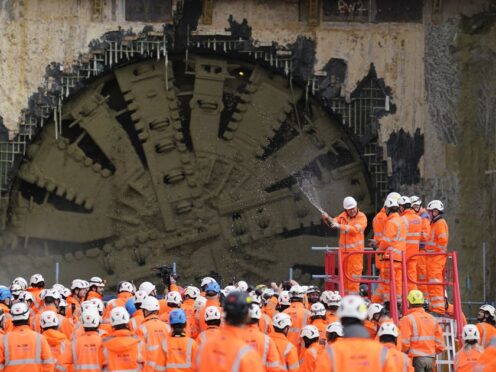Excavation of HS2’s longest tunnel has been completed after a second machine reached the end of its 10-mile journey under the Chiltern Hills.
The machine, named Cecilia, broke through on Thursday at a site near South Heath, Buckinghamshire.
It was one of two tunnel boring machines (TBMs) digging a twin-bore tunnel with a depth of up to 80 metres that will be used for HS2 trains travelling between London and Birmingham.
The other TBM, named Florence, broke through last month.
They both began their journeys near Rickmansworth, Hertfordshire, close to the M25 motorway.

Cecilia, named after Buckinghamshire-born astronomer and astrophysicist Cecilia Payne-Gaposchkin, was launched in June 2021.
This was two months later than Florence, named after Florence Nightingale, the founder of modern nursing.
HS2 Ltd said each machine operated as an “underground factory” with crews of around 17 people working in shifts to keep them running constantly.

They excavated the tunnel, lining it with 112,000 pre-cast concrete wall segments and grouting them into position, moving forward at an average speed of 16 metres per day.
HS2 Ltd’s head of civil works for this section of the route, Mark Clapp, said: “Today is a remarkable achievement for all concerned.
“Cecilia’s arrival completes excavation of HS2’s 10-mile twin-bore tunnel, but it’s only the end of the first chapter in the story of building Britain’s high-speed railway under the Chiltern Hills.
“Several years of intensive, world class engineering lies ahead of us to complete the tunnels’ four ventilation shafts plus headhouses; install the mechanical and electrical plant and machinery, slab track and overhead electrical wires before trains begin passing through at 200mph.”

Headhouses are buildings on top of ventilation shafts which contain air flow and ventilation systems.
The TBMs, which each have a diameter of 10.25 metres, were manufactured in Germany by specialist company Herrenknecht.
They were operated by HS2’s main works contractor Align, which is a joint venture formed of infrastructure companies Bouygues Travaux Publics, Sir Robert McAlpine and VolkerFitzpatrick.

Align’s underground construction director Didier Jacques said: “Ten miles is a long drive for a TBM, with a typical average being around three miles.
“The complexity and technical challenges of completing such a long drive for both our TBMs has been significant, however I am delighted that as a team we have risen to the challenge.
“Both TBMs were designed in partnership with Herrenknecht and incorporate innovations and technologies that have been introduced on TBMs in the UK for the first time, to enhance performance and safety.
“This includes ‘semicontinuous boring’, allowing our TBMs to build the rings that line the tunnels without pausing.”

The machines will be dismantled over the coming weeks, with parts either reused where possible or scrapped.
The three million cubic metres of chalk and other material removed during the tunnelling is being used for a grassland restoration project at the site where the machines were launched.
